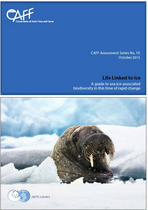The Conservation of Arctic Flora and Fauna (CAFF), the biodiversity working group of the Arctic Council, has released the Life Linked to Ice: a guide to sea-ice-associated biodiversity in this time of rapid change report, detailing changes in marine species and human communities as Arctic sea ice disappears.

The report has found that sea ice loss is affecting the very building blocks of life in the Arctic Ocean with changes resonating throughout entire food webs, affecting everything from ice-dependant algae to birds, fish, marine mammals and human communities that rely on sea ice for travel and food or for economic opportunities. Changes are happening too quickly for some species to cope. Particularly vulnerable are species with limited distributions, specialized feeding or breeding requirements, and/or high reliance on sea ice for part of their life cycles. The report identifies the hooded seal, narwhal and polar bear— species that are vitally important to Indigenous communities— to be vulnerable to change.
The report offers four recommendations for actions:
1. Facilitate a move to more flexible, adaptable wildlife and habitat management and marine spatial planning approaches that respond effectively to rapid changes in Arctic biodiversity.
2. Identify measures for detecting early warnings of biodiversity change and triggering conservation actions.
3. Make more effective use of local and traditional knowledge in Arctic Council assessments and, more broadly, in ecological management.
4. Target resource managers when communicating research, monitoring and assessment findings.
It is important to note that the Arctic is a vast region, and changes will not be uniform across all areas and species. Individual species’ responses to these changes will be uncertain and varied. Sea ice loss should also be viewed in the context of cumulative effects as it is interacting with other stressors, including development impacts, ocean acidification, and accumulation of persistent organic pollutants and mercury in food webs.
Find out more about sea ice associated biodiversity or read the Life Linked to Ice report.